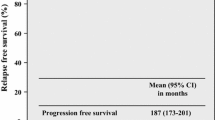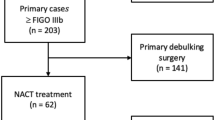Abstract
To explore the relationship of peritoneal, and rectal involvement with lymph nodal metastases to identify clinical parameters to guide systematic nodal dissection in advanced ovarian cancer (stage 3c). It is a retrospective study of stage III C epithelial ovarian cancers undergoing cytoreductive surgery with systematic nodal dissection, from January 2011 to December 2016. LS3 score is a cumulative score given for the presence of size 3 lesion (peritoneal disease measuring more than 5 cm) in regions 5, 6, and 7. The depth of rectal involvement was assigned progressive numerical values from 1 (for serosa) to maximum 4 (for mucosa) to generate rectal involvement score. There were 91 patients. 48.35% patients had LS3 lesions in regions 5, 6, 7. Of these, 36% (27/44) had positive nodes. Of the 41 node-positive cases, 43.9% had single and 34.14% had two station involvements. Rectum was involved in 47 patients (51.64%), serosal involvement being the most common type (50.57%). Twenty patients had positive mesorectal nodes (42.55%). The presence of rectal involvement was influenced by the Peritoneal Carcinomatosis Index (PCI) score, the presence of LS3 in lower quadrants (p = 0.008), and LSE score of lower quadrants (p = 0.003). With the increasing depth of rectal infiltration, mesorectal positivity increased significantly (p = 0.000). In multivariate analysis, lower quadrant (regions 5, 6, 7) PCI, LS3 in lower quadrants, LS3 score, rectal involvement score, and the total number of lines of chemotherapy significantly affected different nodal disease parameters. In advanced ovarian cancer, LS3 disease in regions 5, 6, and 7 and rectal involvement directly impact the nodal metastasis and hence mandates a systematic nodal dissection. Mesorectal nodal involvement significantly increases with the increasing depth of rectal involvement necessitating systematic mesorectal nodal clearance for all rectal resections.
Similar content being viewed by others
References
Tsuruchi N, Kamura T, Tsukamoto N, Akazawa K, Saito T, Kaku T, To N, Nakano H (1993) Relationship between paraaortic lymph node involvement and intraperitoneal spread in patients with ovarian cancer--a multivariate analysis. Gynecol Oncol 49(1):51–55
Burghardt E, Girardi F, Lahousen M, Tamussino K, Stettner H (1991) Patterns of pelvic and paraaortic lymph node involvement in ovarian cancer. Gynecol Oncol 40(2):103–106
Kim HS, Ju W, Jee BC, Kim YB, Park NH, Song YS, Kim SC, Kang SB, Kim JW (2010) Systematic lymphadenectomy for survival in epithelial ovarian cancer: a meta-analysis. Int J Gynecol Cancer 20(4):520–528
Chan JK, Urban R, Hu JM, Shin JY, Husain A, Teng NN, Berek JS, Osann K, Kapp DS (2007) The potential therapeutic role of lymph node resection in epithelial ovarian cancer: a study of 13 918 patients. Br J Cancer 96(12):1817–1822
du Bois A, Reuss A, Harter P, Pujade-Lauraine E, Ray-Coquard I, Pfisterer J et al (2010) Potential role of lymphadenectomy in advanced ovarian cancer: a combined exploratory analysis of three prospectively randomized phase III multicenter trials. J Clin Oncol 28(10):1733–1739
Chang S-J, Bristow RE, Ryu H-S (2012) Prognostic significance of systematic lymphadenectomy as part of primary debulking surgery in patients with advanced ovarian cancer. Gynecol Oncol 126(3):381–386
Rouzier R, Bergzoll C, Brun J-L, Dubernard G, Selle F, Uzan S, Pomel C, Daraï E (2010 Nov) The role of lymph node resection in ovarian cancer: analysis of the surveillance, epidemiology, and end results (SEER) database. BJOG Int J Obstet Gynaecol 117(12):1451–1458
Panici PB, Maggioni A, Hacker N, Landoni F, Ackermann S, Campagnutta E et al (2005) Systematic aortic and pelvic lymphadenectomy versus resection of bulky nodes only in optimally debulked advanced ovarian cancer: a randomized clinical trial. JNCI J Natl Cancer Inst 97(8):560–566
Maggioni A, Benedetti Panici P, Dell’Anna T, Landoni F, Lissoni A, Pellegrino A et al (2006) Randomised study of systematic lymphadenectomy in patients with epithelial ovarian cancer macroscopically confined to the pelvis. Br J Cancer 95(6):699–704
Zhou J, Sun J-Y, Wu S-G, Wang X, He Z-Y, Chen Q-H, Li FY (2016) Risk factors for lymph node metastasis in ovarian cancer: implications for systematic lymphadenectomy. Int J Surg 29:123–127
Bachmann C, Krämer B, Brucker SY, Stäbler A, Fend F, Wallwiener D et al (2014) Relevance of pelvic and para-aortic node metastases in early-stage ovarian cancer. Anticancer Res 34(11):6735–6738
Powless CA, Aletti GD, Bakkum-Gamez JN, Cliby WA (2011) Risk factors for lymph node metastasis in apparent early-stage epithelial ovarian cancer: implications for surgical staging. Gynecol Oncol 122(3):536–540
Ditto A, Martinelli F, Reato C, Kusamura S, Solima E, Fontanelli R, Haeusler E, Raspagliesi F (2012) Systematic Para-aortic and pelvic lymphadenectomy in early stage epithelial ovarian Cancer: a prospective study. Ann Surg Oncol 19(12):3849–3855
Sudolmuş S, Köroğlu N, Yıldırım G, Ülker V, Gülkılık A, Dansuk R (2014) Can CA-125 predict lymph node metastasis in epithelial ovarian cancers in Turkish population? [Internet]. Disease Markers. [cited 2018 Nov 6]. Available from: https://www.hindawi.com/journals/dm/2014/492537/
Kim HS, Park NH, Chung HH, Kim JW, Song YS, Kang SB (2008) Significance of preoperative serum CA-125 levels in the prediction of lymph node metastasis in epithelial ovarian cancer. Acta Obstet Gynecol Scand 87(11):1136–1142
Pereira A, Pérez-Medina T, Magrina JF, Magtibay PM, Rodríguez-Tapia A, de León J et al (2014) Correlation between the extent of intraperitoneal disease and nodal metastasis in node-positive ovarian cancer patients. Eur J Surg Oncol 40(8):917–924
Sakai K, Kamura T, Hirakawa T, Saito T, Kaku T, Nakano H (1997 Apr 1) Relationship between pelvic lymph node involvement and other disease sites in patients with ovarian Cancer. Gynecol Oncol 65(1):164–168
Halkia E, Spiliotis J, Sugarbaker P (2012) Diagnosis and management of peritoneal metastases from ovarian cancer [Internet]. Gastroenterology Research and Practice. [cited 2017 Nov 29]. Available from: https://www.hindawi.com/journals/grp/2012/541842/
Di Giorgio A, Cardi M, Biacchi D, Sibio S, Accarpio F, Ciardi A et al (2013) Depth of colorectal-wall invasion and lymph-node involvement as major outcome factors influencing surgical strategy in patients with advanced and recurrent ovarian cancer with diffuse peritoneal metastases. World J Surg Oncol 11:64
Author information
Authors and Affiliations
Corresponding author
Additional information
Publisher’s Note
Springer Nature remains neutral with regard to jurisdictional claims in published maps and institutional affiliations.
Electronic Supplementary Material
Supplementary Table 1
(DOCX 13 kb)
Supplementary Figure 1
(DOCX 38 kb)
Rights and permissions
About this article
Cite this article
Kammar, P., Bhatt, A., Anam, J. et al. Correlation Between Pelvic Peritoneal Disease and Nodal Metastasis in Advanced Ovarian Cancer: Can Intraoperative Findings Define the Need for Systematic Nodal Dissection?. Indian J Surg Oncol 10 (Suppl 1), 84–90 (2019). https://doi.org/10.1007/s13193-019-00881-1
Received:
Accepted:
Published:
Issue Date:
DOI: https://doi.org/10.1007/s13193-019-00881-1




